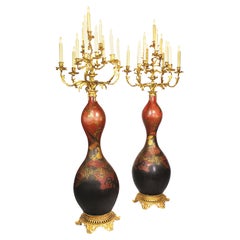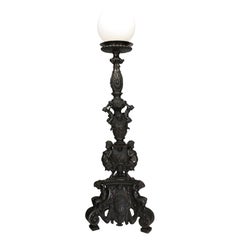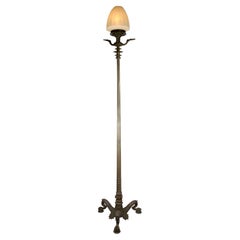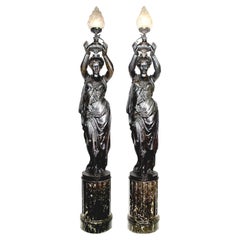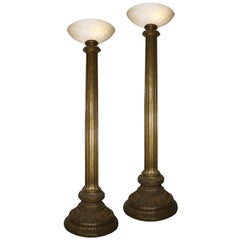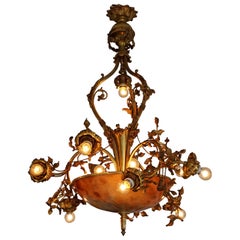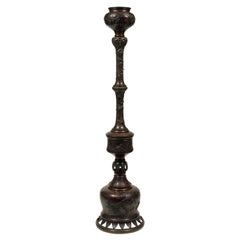Jan's & Co Fine French Antiques Inc. Floor Lamps
to
8
9
9
Height
to
Width
to
3
6
1
1
1
3
6
6
6
9
7
4
4
3
6
4
2
2
2
9
9
9
Pair 19th Century Japanese Porcelain and Gilt Bronze Mounted Torchere Floor Lamp
By Imari Porcelain
Located in Los Angeles, CA
A fine pair of 19th century Japanese porcelain and French gilt bronze mounted thirteen-light celadon torchiere, floor lamp candelabra. Wired for ...
Category
Antique 19th Century Japanese Rococo Floor Lamps
Materials
Bronze
Pair 19th Century Japanese Imari Porcelain & Gilt-Bronze Torchere Candelabra
By Imari Porcelain
Located in Los Angeles, CA
A fine Pair of 19th century Japanese Imari Porcelain and French Gilt-Bronze Mounted Thirteen-Light Celadon Torchere Candelabra. The bottle-shaped Japonisme vases with a Royal red background, decorated with parcel-gilt and black soaring eagles in the hunt within a forestall scene. Each Vase fitted and surmounted with a French 19th century Louis XV Style 13-Light scrolled candelabrum and all raised on a circular pierced gilt-bronze plinth. circa: 1880.
Imari Porcelain (????) is the name for Japanese porcelain wares made in the town of Arita, in the former Hizen Province, northwestern Kyushu. They were exported to Europe extensively from the port of Imari, Saga, between the second half of the 17th century and the first half of the 18th century. The Japanese as well as Europeans called them Imari. In Japanese, these porcelains are also known as Arita-yaki (???). Imari or Arita porcelain has been continously produced up through the present day.
Characteristics
Though there are many types of Imari, Westerners' conception of Imari in the popular sense is associated only with a type of Imari produced and exported in large quantity in mid-17th century. This type is called Kinrande. Kinrande Imari is colored porcelain with cobalt blue underglaze and red and gold overglaze. The color combination was not seen in China at that time. Traditional Ming dynasty color porcelain used dominantly red and green, probably due to scarcity of gold in China, whereas gold was abundant in Japan in those days. The subject matter of Imari is diverse, ranging from foliage and flowers to people, scenery and abstractions. Some Imari design structures such as kraak style were adopted from China, but most designs were uniquely Japanese owing to the rich Japanese tradition of paintings and costume design. The porcelain has a gritty texture on the bases, where it is not covered by glaze. There is also blue and white Imari. Kakiemon style Imari is another type of Imari, but it tends to be categorized separately in Europe.
History
"Imari" was simply the trans-shipment port for Arita wares. It was the kilns at Arita which formed the heart of the Japanese porcelain industry.
Arita's kilns were set up in the 17th century, when kaolin was discovered in 1616 by the immigrant Korean potter, Yi Sam-pyeong (1579–1655). (He may also be known by the name, "Kanage Sambei".) Yi Sam-Pyeong, along with his extended family of 180 persons, left Korea on the offer of a privileged position in Japan. This decision was made after the occurrence of certain Japanese invasions of Korea. After Yi Sam-Pyeong's discovery, his kilns began to produce revised Korean-style blue and white porcelains, known as "Shoki-Imari".
In the mid-17th century there were also a lot of Chinese refugees in Northern Kyushu due to the turmoil on Chinese continent, and it is said one of them brought coloring technique to Arita. Thus Shoki-Imari developed into Ko-KutaniImari. Ko-Kutani was produced around 1650 for both export and domestic market. Blue and white porcelain continued to be produced and they are called Ai-Kutani. Ko-Kutani Imari for the export market usually adopted Chinese design structure such as kraak style, whereas Ai-Kutani for the domestic market were highly unique in design and are accordingly valued very much among collectors.
Ko-Kutani style evolved into Kakiemon style Imari, which was produced for about 50 years around 1700. Imari achieved its technical and aesthetic peak in Kakiemon style, and it dominated European market. Blue and white Kakiemon is called Ai-Kakiemon. Kakiemon style transformed into Kinrande in the 18th century. Kinrande used blue underglaze and red and gold overglaze, and later some other colors.
Imari began to be exported to Europe because the Chinese kilns at Ching-te-Chen were damaged in the political chaos and the new Qing dynasty government stopped trade in 1656–1684. Exports to Europe were made through the Dutch East India Company, but the designation "Imari Porcelain" in Europe connotes Arita wares of mostly Kinrande Imari.
Export of Imari to Europe stopped in mid-18th century when China began export to Europe again, since Imari was not able to compete against China due to high labor cost. By that time, however, both Imari and Kakiemon style were already so popular among Europeans, Chinese export porcelain copied both Imari and Kakiemon style, which is called Chinese Imari. At the same time, European kilns, such as Meisen also tried to copy Imari and Kakiemon.
Export of Imari surged again in late 19th century (Meiji era) when Japonism flourished in Europe. Thus in western world today, two kinds of Imari can...
Category
Antique 19th Century Japanese Japonisme Floor Lamps
Materials
Bronze, Ormolu
$24,850 Sale Price / set
49% Off
An Italian 19th Century Patinated Bronze Torchere, After Niccolò Roccatagliata
By Niccolo Roccatagliata
Located in Los Angeles, CA
A Large and Impressive Italian 19th Century Patinated Bronze Figural Torchere, after a model by Niccolò Roccatagliata (Genoa 1593 - Venice 1636). The triangular foot base with projecting putti supporting the stem and oval reserves within cartouche motifs, one containing the initials "S.D" with an olive tree in-between and a bull-head below. The stem knot with figures of winged caryatids and festoons and upper part with cherub heads, acanthus leaves and egg and bead patterns and topped with a later white glass globe. The decorative system refers to the documented artistic production of the Venetian workshop of Niccolò Roccatagliata and takes inspirational model from the base of the Renaissance bronze of the Scuola Grande di San Teodoro in Venice, a work signed by Andrea del Bartolomeo di Alessandri known as Brescianino. Electrified. Circa: Venice, 1850-1880.
RELATED LITERATURE
L. Planiscig, Venezianische Bildhauer der Renaissance, Vienna, 1921, figs. 661-664; C. Avery, 'Andrea del Bartolomeo di Alessandri detto il Bresciano" lavator di gettar di Bronzo": candelabri, satiri e battenti', M. Ceriana and V. Avery (eds.), L'Industria artistica del Bronzo del Rinascimento a venezia e nell'Italia settentrionale, Venice, 2008, pp. 233-252.
Similar models of this torchere were part of the interior decor collection at the Vanderbilt Mansion in New York (see black and white photo). The Cornelius Vanderbilt II House was a large mansion built in 1883 at 1 West 57th Street in Manhattan, New York City. It occupied the frontage along the west side of Fifth Avenue from West 57th Street up to West 58th Street at Grand Army...
Category
Antique 19th Century Italian Baroque Floor Lamps
Materials
Bronze
$14,850 Sale Price
69% Off
Pompeiian Style 19th-20th Century Bronze Tripod Torchere, Attr. E.F. Caldwell
By Edward F. Caldwell & Co.
Located in Los Angeles, CA
A Rare Tall Pompeiian Style 19th-20th century gilt patinated bronze tripod torchere Floor Lamp fitted with a molded glass shade. The tall fluted center column, topped with decorated ...
Category
Antique Early 1900s American Empire Revival Floor Lamps
Materials
Bronze
$9,850 Sale Price
60% Off
Pair of French 19th-20th Century Neoclassical Style Cast Iron Figural Torchères
Located in Los Angeles, CA
A very fine pair of French 19th-20th century neoclassical style patinated cast iron figural torchères by A. Durenne, Paris, each representing a figure of a standing young maiden, her arms raised forward while holding a a flaming urn gas light (Now electrified) with a frosted glass flame, each raised on a veined grey marble column stand, both cast-signed 'A. Durenne, Paris'. Antoine Durenne was an internationally renowned French art founder. He attended École Nationale Supérieure des Beaux-Arts in 1842. Durenne purchased a small foundry in Sommevoire, near the Val d'Osne, Haute-Marne, France and established The Durenne firm, circa Paris, 1900.
Cast-iron had been in production during the 18th century but its inferior status to the more fashionable and delicate wrought iron had generally confined its use to architectural work. By the early 19th century, however, rapid developments of the Industrial Revolution combined with the simultaneous burgeoning of a new middle class provided the impetus for a dramatic Expansion in its application and in a short space of time a proliferation of iron foundries across Europe and America thrived on the production of everything from inkstands to railway stations. The use of cast-iron for garden ornament became particularly widespread at this time, as the possibilities for its mass-production at a fraction of the cost of bronze made it the material of choice for outdoor statuary...
Category
Antique Early 1900s French Neoclassical Revival Figurative Sculptures
Materials
Marble, Iron
$49,875 Sale Price / set
41% Off
Pair of French Belle Époque 19th-20th Century Gilt Bronze and Alabaster Torchere
Located in Los Angeles, CA
A palatial pair of French Belle Époque 19th-20th century gilt bronze and alabaster tall torchières. The slender center column raised on a circular intri...
Category
Antique Early 1900s French Belle Époque Floor Lamps
Materials
Alabaster, Bronze
$19,850 Sale Price / set
42% Off
Pair of 19th-20th Century Florentine Cut-Glass Fruit Girandole Table Lamps
Located in Los Angeles, CA
A pair of Italian 19th-20th century Florentine cut-clear and color glass four-lights girandoles table lamps. The scrolled bronze frame with four scrolled candle-arms, surmounted with...
Category
Antique Early 1900s Italian Rococo Revival Table Lamps
Materials
Bronze
$4,985 Sale Price / set
23% Off
Pair French 19th-20th Century Neoclassical Style Iron and Parcel-Gilt Torcheres
Located in Los Angeles, CA
A Palatial Pair of French 19th/20th Century Neoclassical Revival Style Ebonized Cast-Iron and Parcel-Gilt Torcheres (torchières - Lamp Posts). The park-like torcheres surmounted with...
Category
Antique Early 1900s French Neoclassical Revival Floor Lamps
Materials
Iron, Zinc
$19,850 Sale Price / set
30% Off
Fine French 19th-20th Century Louis XV Style Belle Epoque Gilt-Bronze Torchere
Located in Los Angeles, CA
A fine and Large French 19th-20th century Louis XV Style Belle Époque gilt bronze four-light torchère with Laurel Wreaths with white opaline glass globes, raised on a two-tone circul...
Category
Antique Early 1900s French Louis XV Floor Lamps
Materials
Marble, Bronze
$24,950 Sale Price
35% Off
Related Items
Fine Gilt Bronze and Alabaster Belle Époque Chandelier
Located in Antwerp, BE
A fine bronze and alabaster Belle Époque chandelier, shaped as swirling and flowering rose branches, early 20th century.
Dimensions: Diameter...
Category
Antique Late 19th Century French Art Nouveau Chandeliers and Pendants
Materials
Alabaster, Brass, Bronze, Copper
$3,638 Sale Price
36% Off
H 39.38 in Dm 29.53 in
19th Century Antique Japanese Meiji Bronze Floor Lamp
Located in Point Richmond, CA
19th century antique Japanese Meiji bronze floor lamp.
This finely cast, well composed, pedestal lamp depicts mythical creatures on the base, cranes in high relief on the stem are...
Category
Antique Late 19th Century Japanese Meiji Floor Lamps
Materials
Bronze
Antique Pair Japanese Chinese Imari Porcelain Ormolu Table Lamps Blue Red Gilt
Located in Dublin, Ireland
Stunning Pair Traditional Japanese Imari Bulbous Form Porcelain Vases of medium to large proportions, now converted to a pair of electric Table Lamps, complete with ormolu stepped ci...
Category
Antique 19th Century Chinese Late Victorian Vases
Materials
Ormolu
$2,096 / set
H 17 in W 4.75 in D 4.75 in
E.F. Caldwell Attr. Silvered Metal Mirrored Sconce
By Edward F. Caldwell & Co.
Located in Astoria, NY
E.F. Caldwell Attributed Silvered Metal Star Form Mirrored Wall Sconce, circa 1900, with two brass arms with two lights and etched starburst and moon face to the mirror. 15" H x 12" ...
Category
Antique Early 1900s Belle Époque Wall Lights and Sconces
Materials
Brass
Matching Pair of Figural Patinated Bronze Flame Torcheres after Clodion
By Claude Michel Clodion
Located in Vancouver, British Columbia
A beautifully cast matching pair of patinated bronze figural torcheres in the manner of Clodion modeled as classically draped young girls with garlands of flowers in their hair and h...
Category
Antique Late 19th Century French Napoleon III Floor Lamps
Materials
Bronze
Antique 19th Century Japanese Imari Porcelain Vase
By Imari Porcelain
Located in Pearland, TX
19th-Century Japanese Imari porcelain vase. This fine vase have a lovely shape and hand painted floral designs in the traditional Imari colors.
Category
Antique 19th Century Japanese Japonisme Vases
Materials
Porcelain
19th Century Pair of Imari Porcelaine Lamp Mounted Gilt Bronze
By Imari Porcelain
Located in Marseille, FR
19th century pair of porcelain lamp from Imari. Frame gilt bronze decorations of metal polychrome flowers.
Category
Antique 19th Century Chinese Chinese Export Ceramics
Materials
Porcelain
Pair of 19th Century Japanese Meiji Period Imari Porcelain Vases
By Imari Porcelain
Located in Pearland, TX
A gorgeous pair of 19th-Century Japanese Meiji Period Imari porcelain vases. These fine vases have a lovely shape and hand painted floral designs in the traditional Imari colors. The...
Category
Antique Late 19th Century Japanese Vases
Materials
Porcelain
$1,495 Sale Price / set
21% Off
H 10.25 in W 6 in D 6 in
Spanish Baroque Wrought Iron Torchere Floor Lamp
Located in Stamford, CT
Spanish Baroque style wrought iron torchère floor lamp with black patina. Beautifully hand wrought and turned shaft supported by a tripod base.
This date from the early 20th century, a time when Italian and Spanish Baroque furniture...
Category
Early 20th Century Spanish Baroque Floor Lamps
Materials
Wrought Iron
Pair of 19th Century French Gilt Bronze Mounted Cassolettes
Located in Atlanta, GA
A Fine Pair of Louis XV style Cassolettes, ormolu mounted Fleur de Peche Marble Lidded Urns with flame finial and raised on paw feet with t tripartite base. France, circa 1880.
Dimen...
Category
Antique 1880s French Louis XV Urns
Materials
Marble, Bronze
Pair of 19th Century French Louis XVI Style Torchieres
Located in Houston, TX
Pair of French Louis XVI style candelabra torchieres.
Category
Antique Late 19th Century French Louis XVI Floor Lamps
Materials
Wood
Pair of 19th Century Meiji Period Japanese Imari Porcelain Vases
By Imari Porcelain
Located in Pearland, TX
A gorgeous pair of antique 19th-Century Japanese Imari vases made in the Meiji period, circa 1870. These fine vases have a lovely lobed shape and hand painted floral design in the tr...
Category
Antique Mid-19th Century Japanese Meiji Vases
Materials
Porcelain

